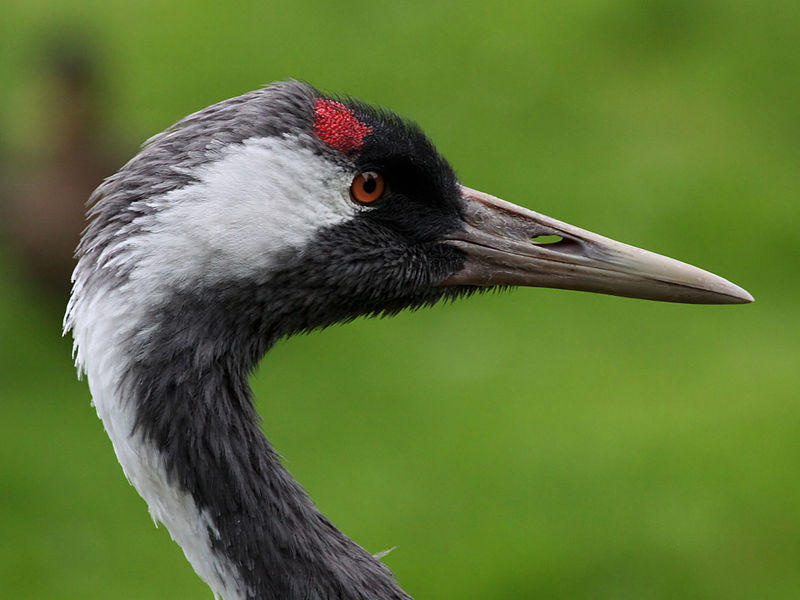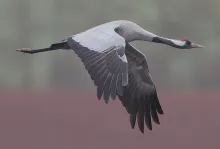
Eurasian crane (Grus grus)
Species name
- Dutch name:
- Europese kraanvogel
- English name:
- Eurasian crane
- German name:
- Kranich
- French name:
- Grue cendrée
- Scientific name:
- Grus grus
Scientific classification
- Order:
- Gruiformes
- Family:
- Gruidae
- Onderfamilie:
- Gruinae
- Genus:
- Grus
Description
- Description:
Male and female:
Adults of both sexes have the forehead and lores blackish, covered with black, hairlike feathers, and the crown likewise nearly bare of feathers but red. The nape is slate gray, and the chin, throat, and anterior portion of the neck are blackish or very dark gray. A white stripe extends from behind the eyes through the ear coverts around and behind the nape, and then down the neck to the upper back. The rest of the body plumage is slaty gray, being darkest on the back and rump and lighter on the breast and wings. The back is often tinged with brownish in breeding birds. The primaries, the tips of secondaries, the alula, the tip of the tail, and the edges of upper tail coverts are black, while the bases of the rectrices are slaty grey. The inner secondaries may be lighter than the rest of the plumage, or about the same color as the other wing and body feathers (grus). The innermost greater coverts are greatly elon-gated and drooping. The legs and toes are black, and the iris varies from yellow to reddish brown or crimson.Juveline:
Juveniles have pale yellowish brown edges on their body feathers, and the crown is covered by feathers; there also are no drooping inner wing feathers. From the first autumn, the new feathers of the head and neck are gray, tipped with cinnamon.
Standard Measurements
- Body Length (cm):
- The male (drake) of the Eurasian crane measures approximately 100–130 centimeters. The female measures approximately 100–130 centimeters.
- Body Weight (grams):
- The male will weight about 4600-6100 gram. The female will weight about 4600-6100 gram.
The weight is notoriously variable and can only be used as indication!
- Breeding:
- The female Eurasian crane usually lays from 2-3 pale cream or yellow-tinged white with brownish spotted eggs and incubates them for 29-31 days.
- Bird banding:
- Recommended closed leg band ring size for the Eurasian crane is 18 mm.The leg band ring can only be applied on a young crane at around 0 days old.
- It doesn't matter what leg that you band, but it's good to have a consistent system. Suggested: Left leg = Female, Right leg = Male
- Maintenance food:
-




The Lundi Crane Regular is much more than just an animal feed. Your pets will love the food.
- Regulation:
- CITES bijlage A
- Regulation:
Deze soorten dienen altijd vergezeld te gaan van een CITES-document. Hierop staat o.a. de geboortedatum, de soortnaam, het geslacht en andere informatie zoals het ringnummer en de diameter van de ring die relevant zijn om het dier te identificeren. Dit internationale paspoort moet altijd bij het dier blijven, waar het ook heengaat.Houders van CITES A soorten dienen een register(boekhouding) bij te houden waarin men o.a. noteert het nummer van het CITES-document, soortnaam, de datum van aankoop en eventuele latere verkoop, verkregen jonge dieren en de datum van overlijden. Een voorbeeld van dit register is te downloaden via www.cites.org.Bij het verkrijgen van nakweek uit CITES A vogels dienen deze geringd te worden met een erkende, geregistreerde ring met een vaststaande diameter. Zolang de nakweek vogels in uw bezit blijven, op het adres dat gelijk is aan dat waar de oudervogels zich bevinden, is een CITES-document voor hen nog niet noodzakelijk.Zodra u de nakweek wilt overdoen aan een andere eigenaar dient u voor de vogels een CITES document aan te vragen. Dit gaat op basis van de CITES documenten van de beide oudervogels. Als de CITES-documenten in uw bezit zijn mag de nakweek uw adres verlaten, NIET eerder! In uw registratie noteert u dan waar de betrokken dieren heengaan.


